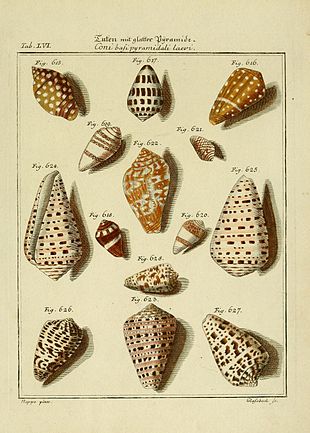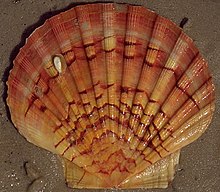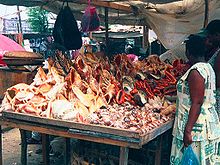Conchology

The Conchology ( give a wiki. Κόγχη [conch] and lat. Concha , "Shell", and give a wiki. Λόγος [lógos], "teaching") deals as a branch of zoology , while the Malacology primarily with the study of the shells of shell molluscs . In addition, the term Conchyologie or Konchyliologie is used, derived from the word Conchylien ( Eng . Also Conchilien , shells of the molluscs); In French, the term conchyologie is used exclusively . Today, the distinction between malacology and conchology is often perceived as artificial and the use of one or the other name essentially results from the respective tradition.
General
Although the word conchology etymologically only refers to mussels, in practice it means dealing with all groups of shell-bearing molluscs. In addition, conchology often also includes the study of the molluscs themselves (in particular snails , mussels , beetle snails, and scabbards ). Shell parts (e.g. operculum ) are also the subject of conchology. In addition to the groups mentioned, the cephalopods also belong to this group, which (with the exception of the pearl boats ) do not have any outer shells because they developed into inner shells in the course of evolution and so u. a. now serve the buoyancy. Other groups, such as the nudibranchs , have completely lost their shell skeleton, both inside and outside, or have been replaced by a cartilaginous structure - they too are often considered to be the subject of research in conchology.
Most of the time, interest in this subject begins rather coincidentally with the collection of mussel shells because of the recognizable aesthetics and the extremely high diversity of shape, color and shape of the shells.
History of Conchology
The collecting of mussels has a long tradition, because the mussel meat served as a welcome food and the mussel shells could be used to make jewelry. Necklaces made from shells can be found as early as the Stone Age , some even far away from larger bodies of water or seas, which suggests that these pieces of jewelry were used as merchandise. These were so widespread that they can be found in almost all excavations, for example in Aztec temple ruins , excavations in ancient China or in ancient Indus cultures .
Mussels also have a long tradition as a means of payment . The shells of cowrie shells in particular were very widespread as such and were used almost worldwide between the 13th century BC and in isolated cases into the 20th century.
During the Renaissance , people began to collect beautiful things in so-called Chambers of Wonder and make them available to the public. Because of their attractiveness, diversity and ubiquity, mussels occupied a large place in such collections. Shellfish-bearing molluscs can be found almost everywhere by the sea and also in many land and freshwater habitats . At the end of the seventeenth century the scientific study of mussels began. Martin Lister published the Historia Conchyliorum between 1685 and 1692 , the first comprehensive conchological work with over 1000 drawings and engravings. Friedrich Martini , Johann Hieronymus Chemnitz and Lorenz Spengler made other early contributions.
Georg Eberhard Rumpf (Georgius Everhardus Rumphius; 1627–1702) was another important and at the same time early conchologist who published his findings in 1705 in the work Amboinische Raritäten-Kammer or Treatise of the stone-shelled animals which are called snails and mussels . G. Rumpf did not allow himself to be dissuaded from his research work by several strokes of fate and even blindness. He developed many names that were later picked up and used by Carl von Linné .
In general, conchology / malacology, like all other areas of zoology , was revolutionized by Linnaeus and his nomenclature , because he created the first generally applicable taxonomic standardization and systematics. He described the area of molluscs and mussels in a separate chapter of his Systema Naturae .
In the post-Linnaeus period, shellfish studies also became an official branch of zoology. But there have also been numerous conchologists worth mentioning in the last few decades, for example Baron Georges Cuvier , who around 1800 through comparative anatomical studies recognized essential similarities in the internal body structure between the supposedly so different mussels and snails and combined both in the animal phylum of the molluscs. The Sowerby family researched and collected molluscs for several generations between the 18th and early 20th centuries . With The Voyager's Companion or Shell-Collector's Pilot, John Mawe (1764–1829) probably created the first nature guide for mussels. Hugh Cuming (1791–1865) was another mollusc researcher who was famous for his extensive collection and who had also discovered several new species. Another important work was American Conchology, or Descriptions of the Shells of North America, Illustrated From Colored Figures From Original Drawings, Executed from Nature , published by Thomas Say in 1830 .
Perhaps the most important conchologist of the 20th century was R. Tucker Abbott (1919–1995). He published around 30 works on molluscs and mussels. Some species of snail were named after him, such as the Conus abbotti or the Odostomia abbotti .
However, there were a number of other scientists who studied mollusc shells. These include many geologists and paleontologists who examine the fossil remains of shell molluscs from the earliest times.
Identification of mussels and molluscs
For the identification of mussels and molluscs, general or regional identification books as well as special documents relating to certain taxa are primarily used. "Iconographies", that is, books with little text, but a large number of pictorial representations of mussels, often help with the determination. (Some of them are listed in the literature list).
The tribe of molluscs and mussels is very large and the distinguishing characteristics are not always uniform even within a species and are constantly being discussed among experts. So it happens that every year several species are redefined or delimited from other species to which they previously belonged. The number of species occurring worldwide is estimated at around 100,000.
Practical application of conchology

Today aesthetic aspects play only a subordinate role, at least for conchologists / malacologists who professionally research molluscs and their shells. For some time now, the main focus has been on the rational area. So many conchologists are concerned with the study of molluscs that are useful to humans or that can harm them.
In studying useful molluscs, such as mussels, such as scallops and oysters for food production or pearl clams, which are grown for their pearls, one focuses primarily on the ecology and living conditions to make the breeding more successful and more productive.
In contrast, research into molluscs and bivalve molluscs that are dangerous to humans and the environment focuses on the physiology of the animals in order to develop effective controls that have the least possible negative impact on the environment. One example is originally native to Europe, but now in North America introduced zebra mussel , caused by disruption of natural ecosystems caused and technical equipment a quantified annually for multi-million dollar economic damage. Another example are poisonous cone snails that emit neurotoxins, which can also be dangerous to humans.
Organizations
Similar to other scientific specialties, the conchologists are organized in various local, regional and international clubs and associations. The major associations include:
- Societe Internationale de Conchyliologie based in Lausanne
- Concholists of America .
- Conchological Society of Great Britain & Ireland
- Association of German Conchylia Collectors
- Conchlogical Association of Brazil
Museums in German-speaking countries
There are numerous museums that are mainly or at least partially dedicated to the subject of conchology.
In Germany, the Senckenberg Natural History Museum , based in Frankfurt am Main , occupies a prominent position here, on the one hand, because it is one of the largest museums with paleontological departments alongside the Natural History Museum in Berlin , and on the other hand, it also has the German Malacoological Information , which has been published since 1868 Society publishes and deals intensively with the research of fossil and recent mollusc species.
The Zoological State Collection in Munich houses a very extensive collection in its Mollusca section , which was originally brought together by Johann Baptist von Spix during a trip to Brazil at the beginning of the 19th century and supplemented by gifts from Johannes Roth . At the beginning of the 20th century, a number of extensive collections were added. The mollusc section of the State Collection is now one of the most extensive in Germany with a stock of around half of all known mollusc species worldwide and is also very active in the field of research.
The Düsseldorf- based Aquazoo-Löbbecke Museum houses around 250,000 fossil and recent marine molluscs in its Löbbecke collection .
A smaller but also very fine collection of fossil shell molluscs is located in the zoo and fossilium in Bochum . The focus here is on the exhibition of exhibits from the Solnhofen fossil deposit in Middle Franconia .
In Austria, the Natural History Museum Vienna is certainly an outstanding faculty in the field of conchology. The mollusc collection currently (April 2008) comprises around 700,000 series, of which approx. 2500 types, the majority of which are shellfish. Furthermore, there is the Landesmuseum Joanneum in Graz , which houses fossil invertebrates , mainly from the Styrian Basin .
In Switzerland, the Natural History Museum in Bern occupies an exposed position with its highly regarded invertebrate section . The collection is based on the legacies of Samuel Emanuel Studer and Robert James Shuttleworth from the 19th century , but has been supplemented and expanded with current donations from well-known conchologists.
Trivia
- In 1839 Edgar Allan Poe and his friend Thomas Wyatt wrote The Conchologist's First Book , a textbook on mollusks and their shells.
literature
- Abbott, RT / Dance, SP: Compendium of Seashells , Dutten, 2000 ISBN 978-0-525-93269-7
- Ardovini, R./Cossignani, T .: West African Seashells . Ancona, 2004 ISBN 88-86070-11-X
- Frýda, J. et al .: Classification and nomenclator of gastropod families , 2005 ISBN 978-3-925919-72-5
- Lindner, Gert: Collecting and determining mussels and snails ., Munich, 2008 ISBN 978-3-8354-0374-1
- Reeve, Lovell .: Elements of Conchology: An Introduction to the Natural History of Shells and of the Animals Which Form Them . London, 1860
Trade journals and periodicals
- Acta Conchyliorum - Club Conchylia magazine (de / en)
- Archive for Molluscology (de)
- Writings on malacoology (de)
- Announcements of the German Malacoological Society (de)
- Malacologia - International Journal of Malacology (en)
- Basteria - Journal of the Dutch Malacol. Society (nl)
- Spirula - news magazine of the Dutch Malacol. Society (nl)
- Journal of Conchology - Periodical of the Conchological Society of Great Britain
Individual evidence
- ↑ http://www.conchologistsofamerica.org/conchology/
- ↑ Jan and Johnson Marion Hogendorn: The Shell Money of the Slave Trade. Cambridge University Press, Cambridge 1986. (Cambridge 2003, ISBN 0-521-54110-7 ) (African Studies Series 49) (English-language standard work on the history of cowrie money)
- ↑ 10th edition of the Systema Naturae in digitized form
- ↑ http://www.vistaverde.de/news/Natur/0307/09_zebramuschel.htm
- ↑ Archived copy ( memento of the original from December 1, 2012 on WebCite ) Info: The archive link was automatically inserted and not yet checked. Please check the original and archive link according to the instructions and then remove this notice.
- ↑ http://www.senckenberg.de/root/index.php?page_id=203/oPal%E4ozoologie%20III/t_self
- ↑ http://www.zsm.mwn.de/mol/index.htm
- ↑ http://www.zsm.mwn.de/mol/research.htm
- ↑ http://www.duesseldorf.de/aquazoo/forschung/index.shtml
- ↑ http://www.tierpark-bochum.de/
- ↑ http://www.nhm-wien.ac.at/Content.Node/forschung/3zoo/mollusca1.html
- ↑ Universalmuseum Joanneum: Geology & Paleontology Collection
- ↑ Natural History Museum Bern: Research and Teaching
- ↑ http://www.uh.edu/engines/epi1090.htm
Web links
- German Malacoological Society (DMG)
- http://www.worldwideconchology.com/ (en)
- Comprehensive collection of knowledge on chonchology (s)
- German Conchylia Association
- Classification of gastropods (private page)
- CLEMAM (Check List of European Marine Mollusca) Taxonomy and systematics of European marine mollusks.
- CLECOM (Check List of European COntinental Mollusca) taxonomy and systematics of European land and freshwater mollusks.

